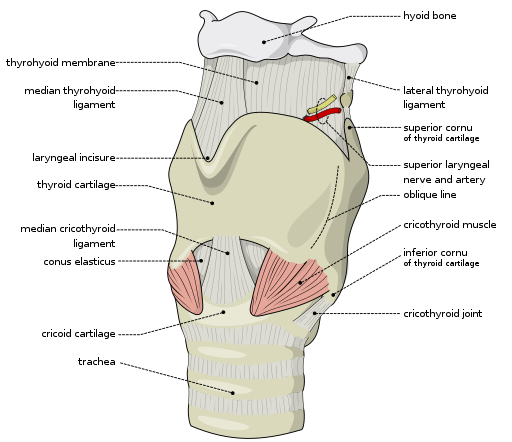There are lots of differing opinions on the subject of laryngeal height for singing and you will hear a lot of prescriptive answers like “the larynx should always be low” or “the larynx should stay neutral” or “you shouldn’t let your larynx rise with pitch”. To quote one of my favorite books on the anatomy and physiology of the human voice “The Voice Clinic Handbook” by Tom Harris and David Howard: “To every complex question there is a simple answer… and it’s wrong!” I believe that the “correct” laryngeal position depends on what sound you’re trying to achieve.
But before I lay out the details of what I believe and why and drown one more opinion in the sea of differing beliefs, I’d like to first acquaint you with some scientific research on the subject. I want to show you what has been objectively observed, what are some possible reasons for some of the strategies commonly taught and what are the differences in laryngeal height for different approaches to singing. If you want to skip all that and just get my opinions on the subject, click here! But you’ll be missing out on the reasons why, which I believe are the most interesting feature of this text.

So without further ado, I want to talk about the link between laryngeal height and pitch. One of the most common mantras you will hear from some schools of vocal technique is that you should not let your larynx rise as you ascend in pitch. So let’s look at several scientific studies measuring laryngeal height through different pitch ranges. A 1975 study by Shipp looked at six untrained young adult males. The conclusion was that “subjects lowered their larynges from the resting position for low-frequency phonation and raised their larynges for higher fundamental frequencies.” However, all of the subjects being untrained could just highlight the need for correcting an instinctive behavior, so let’s look at a paper that was dealing with trained singers. The 1991 paper titled “Supraglottic Contributions to Pitch Raising” by Yanagisawa et al performed velolaryngeal endoscopy on nine professional singers and two untrained subjects. The study showed that “the larynx rose in all subjects with the production of higher frequencies“.
So, the larynx should actually rise with pitch then, right? Not so fast! To every complex question there is a simple answer… and it’s wrong! In preparation for this article and looking up available literature, I was pointed to a 1996 paper by Vilkman et al titled “External Laryngeal Frame Function in Voice Production Revisited”. The authors of this paper did a very thorough literature review on the subject and showed that things aren’t quite as simple. Let’s look at a paragraph from that paper.
“In singing, the entire laryngeal column moves vertically more or less in correlation with pitch. The elevation of the larynx for high pitches and lowering for low pitches, especially in untrained singers, is a well-known phenomenon. In trained singers, however, laryngeal displacement is significantly smaller and can even be reversed.“
Now that’s interesting! That particular study stops at 350 Hz as the highest examined phonation frequency which is probably not the highest these singers can go. The male high C is 523 Hz and the female high C double of that at 1046 Hz, so it would be interesting to see if things still behave the same as those trained singers approach these extremes of their range. Regardless of that, I feel that these results need more context, which will nicely bring us to the next part about differences between different styles of music. Since this is a literature review study, it synthesizes findings across previously published studies. In the case of the cited paragraph, studies quoted as sources have all been done before 1975. Until quite recently, almost no studies have been done on contemporary singing and almost exclusively focused on classical singing. Nowadays we’ve already got plenty of studies done with professional singers singing genres ranging from musical theater to death metal.
So let’s look at some observed differences between classical and contemporary singing in some more recent studies! Schutte and Miller in their 1993 paper “Belting and Pop, Nonclassical Approaches to the Female Middle Voice” say: “Whereas the “classical” approach to the middle range is characterized by the relatively low first formants that result from the widely endorsed “comfortably low” larynx position, the “nonclassical” approach prefers the higher (first) formants of speech. On the open vowels the first formants rise still higher than average speech values in the middle range to keep F1 in the vicinity of the second harmonic.
Although these measurements do not include any formal monitoring of larynx position, both informal observation and theoretical considerations lead us to assume that the higher values of F1 on open vowels in “nonclassical” singing are the result primarily of higher larynx positions. The assumption applies a fortiori to the extreme F1 values seen in high “belting.”“
The same study also gives us the most commonly cited scientific definition of belting which is: “Belting is a manner of loud singing that is characterized by consistent use of “chest” register (>50% closed phase of glottis) in a range in which larynx elevation is necessary to match the first formant with the second harmonic on open (high F 1) vowels.” There are numerous other studies comparing various different contemporary styles of singing with classical styles and the results are always consistently showing that non-classical singers keep their larynges in a higher position compared to classical singers.
But you might have heard that classical technique is the only correct approach to using your voice… That is probably the reason a lot of contemporary coaches teach the larynx shouldn’t rise (but usually don’t insist on making sure that actually happens). That statement is quite easy to knock down because the sound you get is a direct consequence of the technique you use. So if you follow classical technique fully, you will without a doubt end up sounding like a classical singer. It stands to reason that certain adjustments are required to get a sound that is acceptable for contemporary genres and larynx height seems to be the number 1 most commonly observed difference.
So you might ask yourself “What is the difference in sound that the vertical larynx position makes?” A 2021 study titled “Deconstructing Timbre into 5 Physiological Parameters” by Aaen et al found that: “Darkening and lightening the sound color involved altering the size of the vocal tract space related to lowering/raising the larynx, widening/closing the piriform sinuses, increasing/decreasing the distance between stylopharyngeus and palatopharyngeus, increasing/decreasing anterior-posterior narrowing (and the resulting view of the vocal folds), medialising/retracting ventricular folds, and altering supraglottic funnel depth.” So lowering the larynx creates a darker sound color and raising it creates a lighter, brighter sound color. Comparing the sound of a classical and non-classical singer, it’s rather easy to notice that classical singers sound much darker than singers in most other genres and a large part of that obviously stems from their lower laryngeal position.

Now that we got that out of the way, you might still be concerned with vocal health implications of raising the larynx. Where does the idea of a raised larynx being unhealthy come from and is it always true? A raised larynx is a common feature of hyperfunctional dysphonia (a tight, hoarse sound), so ENTs and SLPs are trained to recognize an overly raised larynx as one of the telltale laryngeal gestures of hyperfunctional dysphonia. However, a good belter’s voice obviously very rarely sounds dysphonic. Luckily, we have a 2018 study by Saldias et al titled “A Computerized Tomography Study of Vocal Tract Setting in Hyperfunctional Dysphonia and in Belting”. They found that: “Various similarities were found between belting and hyperfunction: high vertical larynx position, small hypopharyngeal width, and epilaryngeal outlet. On the other hand, belting differed from dysphonia (in addition to higher pitch) by a wider lip and jaw opening, and larger volumes of the oral cavity.” They further hypothesize that what makes belting safe is the so-called megaphone shape of the vocal tract that maximizes efficiency.
The same author further builds upon that in his 2020 study titled “The Vocal Tract in Loud Twang-Like Singing While Producing High and Low Pitches” where the conclusion is that “A wider mouth opening, pharyngeal constriction, and epilaryngeal tube narrowing may be helpful strategies for maximum power transfer and improved vocal economy in loud contemporary commercial music singing and potentially in loud speech.“
And to drive the point home, let’s take a look at a 2022 paper by Aaen et al titled “Extreme Vocals—A Retrospective Longitudinal study of Vocal Health in 20 Professional Singers Performing and Teaching Rough Vocal Effects”. The authors say that “the study shows that specific and systematic supraglottic narrowing in the larynx, hypopharynx, and raising of the larynx to allow supraglottic structures to approximate and vibrate is not damaging to vocal health.” They also warn that “caution should be exerted in determining or diagnosing dysphonia, and vocal health generally, based simply on identification of supraglottic narrowing and larynx elevation, as these are simultaneously healthy and necessary features of healthy metallic vocal modes, alterations in sound coloring, and rough vocal effects, which can all be produced healthily and sustainably according to current literature.“
I hope that after this short literature review, we can agree that laryngeal elevation is a normal part of pitch raising for most singers and styles, that the vertical position of the larynx is an important factor in sound coloring and that there are no health risks to raising your larynx as long as you have a good control of your overall vocal technique (and the same applies to any other laryngeal vertical position).
That finally brings us to the final point of this long-winded rant – What do I believe the correct laryngeal position for singing is? My answer to that is – it depends! Are you singing classical? If yes, your larynx should probably sit comfortably low. Are you singing non-classical? You should probably allow a slightly higher larynx position. Are you trying to belt the high notes like your favorite rock/gospel/Broadway star? You’re probably shooting yourself in the foot if you’re trying to accomplish that without allowing your larynx to raise significantly. Besides that, if you want a darker sound, you should lower your larynx and if you want a brighter, lighter sound, you should raise your larynx. Becoming skilled in controlling laryngeal position is awesome and rewards you with a wide palette of available sounds!
If you’d like to explore these options with me, don’t hesitate to shoot me an e-mail through the website’s contact form and we can schedule a lesson!
